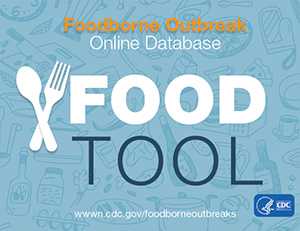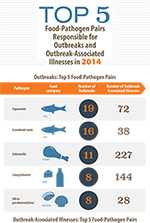Highlights from the 2014 Surveillance Report
When two or more people get the same illness from the same contaminated food or drink, the event is called a foodborne disease outbreak. Outbreaks provide important insights into how germs are spread, which food and germ combinations make people sick, and how to prevent food poisoning. Each year, CDC summarizes foodborne disease outbreak data in an annual surveillance report and makes it available to the public through the FOOD Tool.
Main Findings
In 2014, 864 foodborne disease outbreaks were reported, resulting in 13,246 illnesses, 712 hospitalizations, 21 deaths, and 21 food recalls.
- Single food categories associated with the most outbreak illnesses:
- Seeded vegetables, such as cucumbers or tomatoes (428 illnesses)
- Chicken (354 illnesses)
- Dairy (267 illnesses)
- Single food categories associated with the most outbreaks:
- Fish (43 outbreaks)
- Chicken (23 outbreaks)
- Dairy (19 outbreaks, with 15 linked to unpasteurized dairy products)
- Restaurants (485 outbreaks, 65% of outbreaks reporting a single location of preparation), specifically restaurants with sit-down dining (394, 53%), were the most commonly reported locations of food preparation.
- There were 25 multistate outbreaks, including following types of foods linked to them:
- Ground beef (5 outbreaks)
- Fruits (5 outbreaks)
- Seeded vegetables (3 outbreaks)
- Row crops, such as lettuce and cabbage (3 outbreaks)
Other Highlights
Germs
A single, confirmed agent or germ caused 461 outbreaks. The most commonly reported were:
- Norovirus (34% of the outbreaks)
- Salmonella (30% of the outbreaks)
A single, confirmed germ caused 8,810 outbreak-related illnesses and 665 hospitalizations (about 1 of every 13 illnesses). The most common causes:
- Norovirus (34% of the outbreaks and 43% of the illnesses)
- Salmonella (30% of the outbreaks and 27% of the illnesses)
- Shiga toxin-producing Escherichia coli (5% of the outbreaks and 2% of the illnesses)
The agents that cause the most outbreak-related hospitalizations were:
- Salmonella (395 hospitalizations, 59%of outbreak-related hospitalizations)
- Shiga toxin-producing Escherichia coli (62 hospitalizations,9%of outbreak-related hospitalizations)
- Listeria monocytogenes (51 hospitalizations, 8% of outbreak-related hospitalizations)
The agents that cause the most outbreak-related deaths were:
- Listeria monocytogenes (13 deaths)
- Norovirus (4 deaths)
- Shiga toxin-producing Escherichia coli O157 (1 death)
- Campylobacter (1 death)
- Clostridium botulinum (1 death)
- Salmonella (1 death)
Foods
For 43% of the outbreaks in 2014 (369 outbreaks), investigators were able to identify the food that made people ill. The food could be placed into a single category, out of 24 possible categories, in 205 of those outbreaks, or slightly more than half of them. The most commonly implicated food categories:
- Fish (43 outbreaks, 21% of the outbreaks)
- Chicken (23 outbreaks, 11% of the outbreaks)
- Dairy (19 outbreaks, 9% of the outbreaks)
- Pasteurization information was reported for 18 of the dairy outbreaks
- Fifteen of those outbreaks (83%) involved unpasteurized products
Outbreaks in which the food could be classified into 1 of 24 categories included 2,727 illnesses. Outbreak-associated illnesses were most commonly from:
- Seeded vegetables, such as cucumbers or tomatoes (428 illnesses, 16% of the illnesses)
- Chicken (354 illnesses, 13% of the illnesses)
- Dairy (267 illnesses, 10% of the illnesses)
Combinations of Foods and Germs that Caused Illness, Hospitalizations, and Deaths
Knowing which food and germ combinations make people sick is critically important to stopping future foodborne outbreaks and preventing them altogether. The confirmed germ-food pairs responsible for the most outbreak-related illnesses, hospitalizations, and deaths in 2014 were:
-
Illnesses
- Salmonella in seeded vegetables (357 illnesses)
- Salmonella in chicken (227 illnesses)
- Staphylococcus aureus enterotoxin in turkey (184 illnesses)
-
Hospitalizations
- Salmonella in seeded vegetables (68 hospitalizations)
- Listeria in fruits (36 hospitalizations)
- Salmonella in chicken (23 hospitalizations)
-
Deaths
- Listeria in fruits (8 deaths)
- Norovirus in chicken: (2 deaths)
- Listeria in sprouts (2 deaths)
- Campylobacter in dairy (1 death)
- Clostridium botulinum toxin in fish (1 death)
- Listeria in dairy (1 death)
- Norovirus in chicken (1 death)
- Shiga toxin-producing Escherichia coli in beef (1 death)
The confirmed germ-food pairs responsible for the most outbreaks were:
- Ciguatoxinin fish (9 outbreaks)
- Scombroid toxin (histamine poisoning) in fish (16 outbreaks)
- Salmonella in chicken (11 outbreaks)
Settings
Among the 738 outbreaks and 10,856 illnesses with a reported single location where food was prepared, 484 outbreaks (66%) and 4,777 associated illnesses (44%) were attributed to foods prepared in a restaurant.
Among these outbreaks, sit-down dining-style was the type of restaurant most commonly reported as the location where food was prepared (393 outbreaks, 53%).
Recalls
Product recalls occurred in 21 outbreaks:
- Raw oysters (4 outbreaks)
- Tuna (3 outbreaks)
- Ground beef (2 outbreaks)
- Almond and peanut butter (1 outbreak)
- Apple (1 outbreak)
- Chia seed powder (1 outbreak)
- Chicken (1 outbreak)
- Latin-style soft cheese (1 outbreak)
- Milkshakes (1 outbreak)
- Mung bean sprouts (1 outbreak)
- Romaine lettuce (1 outbreak)
- Pasteurized milk (1 outbreak)
- Peaches (1 outbreak)
- Pesto (1 outbreak)
- Sprouts (1 outbreak)
Outbreaks in Multiple U.S. States
Twenty-five multistate outbreaks outbreaks (3% of all reported outbreaks), resulting in 778 illnesses (6% of illnesses), 194 hospitalizations (27% of hospitalizations), and 11 deaths (55% of deaths).
Germs responsible for multistate outbreaks:
- Salmonella (11 outbreaks)
- STEC (10 outbreaks)
- Listeria (3 outbreaks)
- Norovirus (1 outbreak)
The foods implicated or suspected in the Salmonella multistate outbreaks were:
- Mung bean sprouts (1 outbreak; 1 outbreak)
- Almond and peanut butter (1 outbreak)
- Cantaloupe (suspected; 1 outbreak)
- Cashews (1 outbreak)
- Chia seed powder (1 outbreak)
- Cucumber (1 outbreak)
- Grapes (suspected; 1 outbreak)
- Ground beef (suspected; 1 outbreak)
- Mango (suspected; 1 outbreak)
- Mini cucumbers (suspected; 1 outbreak)
- Mini peppers (suspected; 1 outbreak)
The foods implicated or suspected in the STEC multistate outbreaks were:
- An undetermined food from a Mexican-style chain restaurant (1 outbreak)
- Ground beef in 4 outbreaks (1 confirmed, 3 suspected; 4 outbreaks)
- Cabbage (1 outbreak)
- Clover sprouts (1 outbreak)
- Leaf lettuce (1 outbreak)
- Pre-packaged salad (1 outbreak)
- Spinach (suspected; 1 outbreak)
Foods implicated in the Listeria multistate outbreaks were:
- Mung bean sprouts (1 outbreak)
- Apples (1 outbreak)
- Stone fruit (1 outbreak)
More Information
Why is this report important?
Foodborne diseases due to known pathogens are estimated to cause about 9.4 million illnesses each year in the United States. Even though only a small proportion of these illnesses occur as part of a recognized outbreak, the data collected during outbreak investigations provide insights into the pathogens and foods that cause illness. Public health officials, regulatory agencies, and the food industry can use these data to create control strategies along the farm-to-table continuum that target specific pathogens and foods.
What else do I need to know about this year’s report?
The data from this report come from CDC’s Foodborne Disease Outbreak Surveillance System (FDOSS). State, local, and territorial health departments report the results of foodborne disease outbreak investigations to this system, and CDC provides an annual summary of outbreak investigations.
When comparing data between years, it is important to note that changes were made to this surveillance system in 2009, and a new food categorization scheme was implemented in 2011.
The findings in this report have at least three limitations. First, only a small proportion of foodborne illnesses that occur each year are identified as being associated with outbreaks. The extent to which the distribution of food vehicles and locations of preparation implicated in outbreaks reflect the same vehicles and locations as foodborne illnesses not associated with outbreaks is unknown. Similarly, not all outbreaks are identified, investigated, or reported. Second, many outbreaks had an unknown etiology (cause), an unknown food vehicle, or both, and may not be well represented by those outbreaks in which a food vehicle or etiology could be identified. Finally, CDC’s outbreak surveillance system is dynamic. Agencies can submit new reports and change or delete reports as information becomes available. Therefore, the results of this analysis might differ from those in other reports.
How can I learn how many reported outbreaks were associated with a certain food, germ, or setting?

Foodborne Outbreak Online Database (FOOD Tool) is a web-based program you can use to search CDC’s Foodborne Disease Outbreak Surveillance System database. FOOD Tool lets users search foodborne disease data by year, state, food and ingredient, location where food was prepared, and cause. It provides information on numbers of illnesses, hospitalizations, deaths, the germ, and the confirmed or suspected cause.
For guidance on using the data and limitations to keep in mind when searching by food or ingredient, take a look at frequently asked questions about FOOD Tool.
How can I find out about foodborne disease outbreak trends?
Surveillance for Foodborne Disease Outbreaks – United States, 1998-2008 describes 11 years of data about the causes of outbreaks and where they occur; the pathogens and foods that caused the most outbreaks, illnesses, hospitalizations, and deaths; and trends in the pathogens and foods associated with outbreaks over time. Learn more >
What factors influence outbreak investigation and reporting?
Although foodborne disease outbreaks are a nationally notifiable condition, many factors can influence outbreak investigation and reporting, including available resources (such as time, staff, and laboratory capacity), health department priorities, and the characteristics of an outbreak (such as its size and severity).
Why is the cause of so many reported outbreaks unknown?
Even well-conducted investigations may not be able to identify the cause of an outbreak. Several factors influence whether investigators can identify the cause of an outbreak, including the timing of when a specimen is obtained.
- Infections are often diagnosed using specific laboratory tests that can identify bacteria, chemical agents and toxins, parasites, and viruses. When an outbreak isn’t identified until after the optimal time to obtain specimens from ill people, it may not be possible to obtain specimens for laboratory analysis or the laboratory tests may be negative.
- When timely specimens are obtained, other factors can lead to the cause not being detected. For example, clinical laboratories may not have the resources needed to identify some germs. In these outbreaks, the state public health laboratory or CDC may perform additional tests to try to identify the germ.
Even if the cause is not identified, CDC encourages states to report all foodborne disease outbreak investigations.
Why is the food unknown for so many reported outbreaks?
Even the most thorough investigations can fail to identify the contaminated food under certain circumstances, such as when most of the people who became sick ate many of the same foods (making it hard to identify the one that caused them to become ill), the number of people ill is very small, or the outbreak is identified after people’s memories of what they ate before getting sick have faded. CDC encourages health departments to report all foodborne outbreak investigations. Even if the contaminated food is not determined, we can learn useful information that can help shape prevention efforts.
Learn More About Foodborne Outbreaks
- Page last reviewed: March 18, 2016
- Page last updated: March 18, 2016
- Content source:


 ShareCompartir
ShareCompartir


